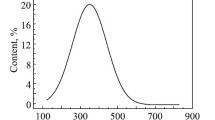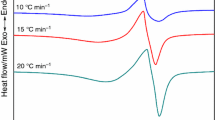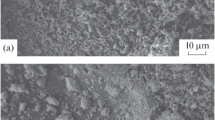Abstract
A one-stage manufacturing technology of aluminum–ceramic skeleton composites by combining the processes of self-propagating high-temperature synthesis (SHS) of a porous skeleton formed by the MAX phase of the Ti2AlC composition and its impregnation by the aluminum melt under pressure (SHS compaction) is considered. A composition of the exothermic charge 2Ti + C + 22.5 wt % Al + 10 wt % TiH2, which provides the formation of a porous skeleton of the Ti2AlC phase without impurity phases by the SHS technology, is selected. It is shown that, when impregnating the hot SHS skeleton with aluminum, new phases are formed such as the MAX phase (Ti3AlC2), titanium carbide (TiC), and titanium aluminide (Al3Ti). However, the content of the basic MAX phase remains high, and the ceramic component of the material consists of Ti2AlC by 76%. When analyzing the microstructure, it is revealed that the composite has certain residual porosity after impregnation and cooling. The influence of the impregnation pressure (q = 22, 28, and 35 MPa) on the distribution of the aluminum content over the height and radius of the diametral sample section is investigated experimentally. It is shown that the nonuniform Al distribution over the sample bulk is caused by the nonuniform pressure and temperature fields, as well as the different compactibility of hot inner and colder outer sample parts. The degree of compaction of characteristic zones is leveled as the impregnation pressure increases, and the composition inhomogeneity over the sample bulk decreases. The difference in aluminum concentration over the sample bulk at q = 35 MPa does not exceed 5%. The SHS-compacted aluminum–ceramic skeleton composite based on the Ti2AlC MAX phase corresponds to high-strength Al-Zn–Mg–Cu aluminum alloys by the hardness level (HB ≈ 150 kg/mm2).
Similar content being viewed by others
References
Adebisi, A.A., Maleque, M.A., and Rahman, M.M., Metal matrix composite brake rotor: historical development and product life cycle analysis, Int. J. Autom. Mech. Eng., 2011, vol. 4, pp. 471–480.
Binner, J., Chang, H., and Higginson, R., Processing of ceramic-metal interpenetrating composites, J. Europ. Ceram. Soc., 2009, vol. 29, pp. 837–842.
Li, J., Binner, J., and Higginson, R., Dry sliding wear behavior of co-continuous ceramic foam/aluminum alloy interpenetrating composites produced by pressureless infiltration, Wear, 2012, vol. 276, pp. 94–104.
Wang, H., Wang, S., Liu, G., and Wang, Y., AlSi11/Si3N4 interpenetrating composites. Tribology properties of aluminum matrix composites, Adv. Mater. Phys. Chem., 2012, vol. 2, no. 4B, pp. 130–133.
Peng, H.X., Fan, Z., and Evans, J.R.G., Bi-continuous metal matrix composites, Mater. Sci. Eng. A, 2001, vol. 303, pp. 37–45.
Lan, J., Yan-li, J., Liang, Y., Nan, S., and You-dong, D., Experimental study and numerical analysis on dry friction and wear performance of co-continuous SiC/Fe–40Cr against SiC/2618 Al alloy composites, Trans. Nonfer. Met. Soc. China, 2012, vol. 22, pp. 2913–2924.
Amosov, A.P. and Borovinskaya, I.P., Merzhanov. A.G., Poroshkovaya tekhnologiya samorasprostranyayushchegosya vysokotemperaturnogo sinteza materialov (Powder Technology of Self-Propagating High-Temperature Synthesis of Materials), Moscow: Mashinostroenie-1, 2007.
Barsoum, M.W., Thermodynamically stable nanolaminates, Progr. Solid State Chem., 2000, vol. 28, pp. 201–281.
Samsonov, G.V., Borisova, A.L., Zhidkova, T.G., et al., Phisiko-khimicheskie svoistva okislov: Spravochnik (Physical and Chemical Properties of Oxides: Reference Book), Moscow: Metallurgiya, 1978.
Samsonov, G.V. and Vinnitsky, I.M., Tugoplavkie soedineniya: (Spravochnik) (Refractory compounds: Reference book), Moscow: Metallurgiya, 1976.
Wang, X.H. and Zhou, Y.C., Layered machinable and electrically conductive Ti2AlC and Ti3AlC2 ceramics: a review, J. Mater. Sci. Technol., 2010, vol. 26, no. 5, pp. 385–416.
Wang, P., Mei, B., Hong, X., and Zhou, W., Synthesis of Ti2AlC by hot pressing and its mechanical and electrical properties, Trans. Nonfer. Met. Soc. China, 2007, vol. 17, pp. 1001–1004.
Ge, Z., Chena, K., Guo, J., Zhou, H., and Ferreira, J.M.F., Combustion synthesis of ternary carbide Ti3AlC2 in Ti–Al–C system, J. Eur. Ceram. Soc., 2003, vol. 23, pp. 567–574.
Levashov, E.A., Pogozhev, Yu.S., Shtansky, D.V., and Petrzhik, M.I., Self-propagating high-temperature synthesis of ceramics on the base of M n + 1AXn phases in the Ti–Cr–Al–C system, Izv. Vyssh. Uchebn. Zaved., Poroshk. Metal. Funkts. Pokryt., 2008, no. 3, pp. 34–46.
Stolin, A.M., Vrel, D., Galyshev, S.N., Hendaoui, A., Bazhin, P.M., and Sytschev, A.E., Hot forging of MAX compounds SHS-produced in the Ti–Al–C system, Int. J. SHS, 2009, vol. 18, no. 3, pp. 194–199.
Meng, F., Liang, B., and Wang, M., Investigation of formation mechanism of Ti3SiC2 by self-propagating high-temperature synthesis, Int. J. Refr. Met. Hard. Mater., 2013, vol. 41, pp. 152–161.
Thomas, T. and Bowen, C.R., Thermodynamic predictions for the manufacture of Ti2AlC MAX-phase ceramic by combustion synthesis, J. Alloys Comp., 2014, vol. 602, pp. 72–77.
Fedotov, A.F., Amosov, A.P., Latukhin, E.I., Ermoshkin, A.A., and Davydov, D.M., The influence of gasifying additives on the phase composition of combustion products in the Ti–C–Al system, Izv. Samar. Nauch. Tsentra Ross. Akad. Nauk, 2014, vol. 16, no. 6, pp. 50–55.
Spencer, C.B., Fiber-Reinforced Ti3SiC2 and Ti2AlC MAX Phase Composites, A Thesis of Master of Science in Materials Science and Engineering, Drexel University: 2010.
Ermoshkin, A.A., SHS-compaction of multicomponent cathodes of the Ti–C–Al and Ti–C–Al–Si systems for vacuum-arc coatings, Extended Abstract of Cand. Sci. Dissertation, Samara: Samara State Tech. Univ., 2012.
Promyshlennye alyuminievye splavy. Spravochnik (Industrial Aluminum Alloys. Reference Book), Kvasov, F.I. and Fridlyander, I.N., Eds., Moscow: Metallurgiya, 1984.
Tuchinsky, L.I., Kompositsionnye materialy, poluchaemye metodom propitki (Composites Made by Impregnation Method), Moscow: Metallurgiya, 1986.
Author information
Authors and Affiliations
Corresponding authors
Additional information
Original Russian Text © A.F. Fedotov, A.P. Amosov, E.I. Latukhin, V.A. Novikov, 2015, published in Izvestiya Vysshikh Uchebnykh Zavedenii. Tsvetnaya Metallurgiya, 2015, No. 6, pp. 53–62.
About this article
Cite this article
Fedotov, A.F., Amosov, A.P., Latukhin, E.I. et al. Fabrication of aluminum–ceramic skeleton composites based on the Ti2AlC MAX phase by SHS compaction. Russ. J. Non-ferrous Metals 57, 33–40 (2016). https://doi.org/10.3103/S1067821216010053
Received:
Revised:
Accepted:
Published:
Issue Date:
DOI: https://doi.org/10.3103/S1067821216010053




